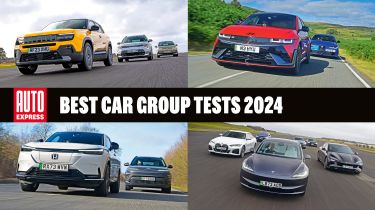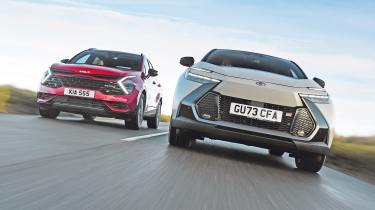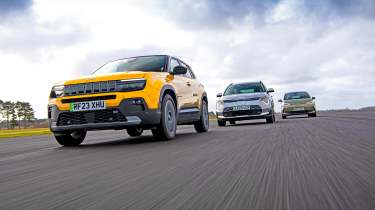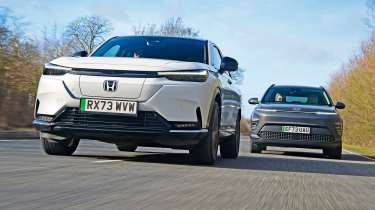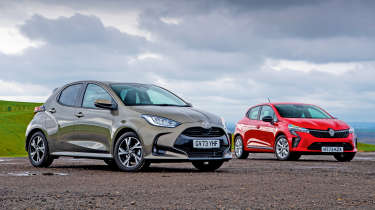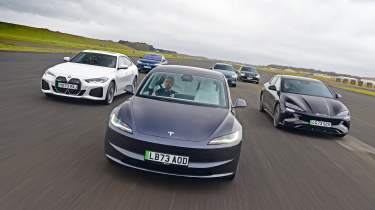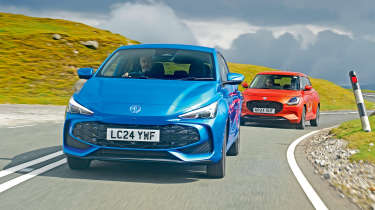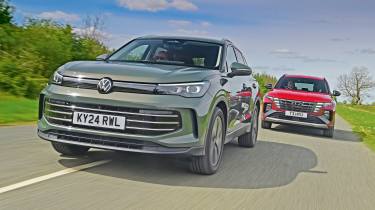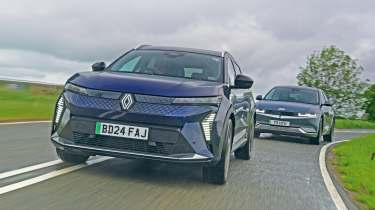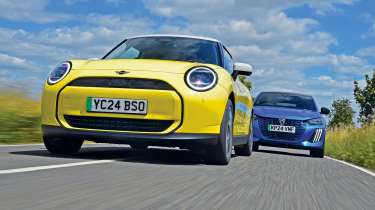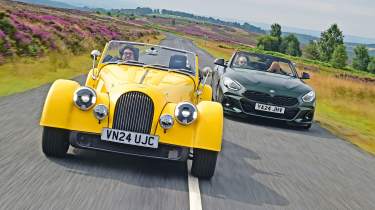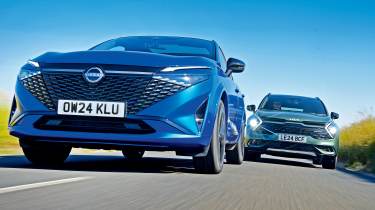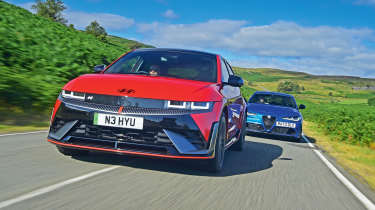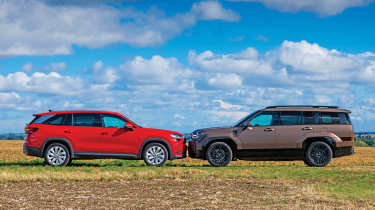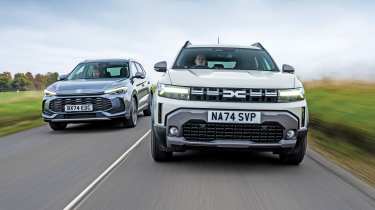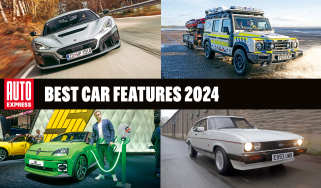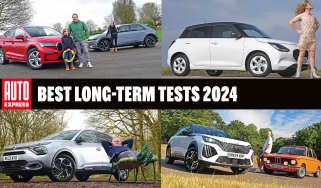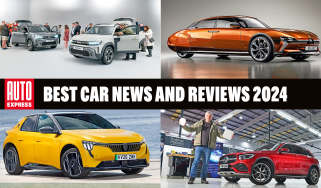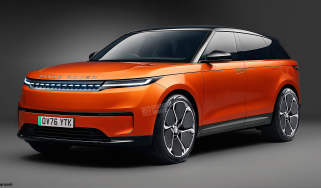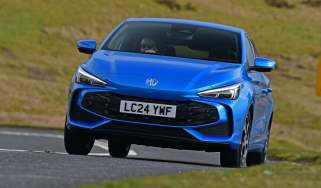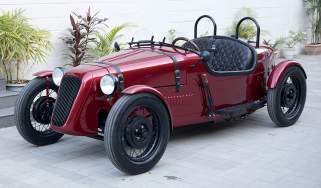Best car group tests 2024: the head-to-heads that stuck in our heads
There’s no place to hide in an Auto Express group test! Here are our favourites from 2024
Auto Express group tests are designed to sort the best from the rest in order to help you make the right choice when it comes to cars. Pitching the latest models against key rivals is one of the most effective ways to find their strengths and weaknesses, and there’s nowhere to hide from our team of expert road testers.
We know our group tests are vitally important to you, which is why we carry out more of them than anyone else and go into greater detail. When you need to make your next new car choice, you know you can rely on the Auto Express group test.
In 2024, we’ve reviewed and studied in detail a greater variety of cars than ever before. From superminis and hatchbacks to electric cars and fastbacks, there have been many deserving victories and a few surprising winners along the way.
Scroll down to find out our team’s favourite group tests of 2024, and click on the links to read the full tests…
January
Updated Vauxhall Corsa is too much for Hyundai i20 to handle
The Vauxhall Corsa is part of the British subconscious. Almost everyone has owned or driven one, so a new Corsa is big business for the brand. As soon as we got our hands on the updated supermini, we pitched it against the recently revised Hyundai i20.
And it was the Corsa that came out on top. With its lively engine, strong refinement and slick infotainment, the vivacious Vauxhall was a clear winner against its Korean rival. The fact the Corsa was much cheaper to finance made it a no-brainer for our road test team.
Sportage edges out Mk2 C-HR
We’re big fans of the Kia Sportage at Auto Express. While we reckon its Hyundai Tucson sister car just about pips it as an overall package, it’s easy to see why the Kia continues to feature in the list of the UK’s top-10 best-selling cars month after month.
It makes sense, therefore, that when a capable crossover presents itself in the mid-size SUV segment, we get on the phone to Kia to see if they can lend us a car for comparison purposes. That was the situation back in January, when Toyota’s latest C-HR landed in the UK, straight off the back of a successful international launch.
But no matter how good the C-HR felt on the tight and twisting roads of Ibiza, it succumbed to the sensational Sportage back in Blighty. We praised the Toyota’s tried-and-tested hybrid tech, and loved its sharp handling and slick new infotainment system. But a cramped cabin, small boot and pronounced wind noise at higher speeds ultimately held it back alongside the practical and more comfortable Kia.
Our verdict at the time conceded that the C-HR looked much more appealing in a cheaper trim level, where it was better able to compete with the generously equipped and good-value Sportage. If you want a stylish and good-to-drive family car, but are beyond the ‘chuck in everything including the buggy and bike’ stage, then Toyota’s newcomer is an excellent alternative to the segment stalwarts.
We went on to feature the C-HR on a number of other occasions across the pages of Auto Express later in the year – both in print and online. We tested the pricier but even more efficient plug-in hybrid in March (Issue 1,823) and even added one to our long-term fleet in June (Issue 1,836). Every time we drove it we came away thoroughly impressed, even if the slightly compromised coupé-styled crossover still can’t quite compete for outright class honours.
February
Affordable small EVs put through paces
Electric cars rose to prominence with a plethora of big, heavy, expensive SUVs. They weren’t that efficient or particularly good to drive, and the compromised interior packaging meant they simply weren’t as usable as their petrol predecessors.
But the market is maturing now and more compact, affordable offerings are increasingly conspicuous. With the level of choice on the up, we brought three of the best small electric cars together to see which should get your hard-earned cash.
The Jeep Avenger, Kia Niro and Volkswagen ID.3 represent three very different takes on the electric family-car formula, but picking a winner wasn’t easy. Our verdict found us splitting hairs: the special-feeling Jeep took top spot thanks to strong finance deals, but there was still plenty to recommend when it came to its two rivals.
If you plan to keep your car for a little longer, it was (and is) impossible to ignore Kia’s seven-year/100,000-mile warranty, for example. Its big boot, decent range and class-leading efficiency ensure the Niro will be an easy car to live with, too.
Then there’s the ID.3, which is vastly improved post-facelift thanks to better interior quality, faster charging and a subtle new look. It may not have the SUV style of the Avenger or Niro, but there’s plenty to be said for VW’s established MEB platform, which provides engaging driving dynamics and a good amount of space inside. The thing that really let it down was the price, which in this company relegated it to last place – but still with an admirable four-star score.
In this area of the market, an attractive monthly finance figure can be the difference between a good car and a great one. In the last 12 months we’ve seen some fairly dramatic price cuts on EVs; Jeep recently slashed up to £5k from the Avenger, and a base-spec ID.3 in Pure Essential trim is now a little over £30,000.
March
New Honda e:NY1 is no match for Kona champ
There was a time when Hyundai would have been the underdog against a brand with a reputation like Honda’s, but welcome to 2024. This twin test put our reigning car of the year up against the new Honda e:NY1.
Why anyone would be interested in the Honda’s average driving dynamics, range and charging performance over the very complete and superbly designed Kona was beyond our testers. Honda needs to step up its game if it wants to avoid being relegated to also-ran status.
April
Refreshed Renault Clio sees off veteran Toyota Yaris hybrid
A stalwart of the Auto Express twin test is the classic supermini showdown, and in April we brought together a Toyota Yaris and the then recently refreshed Renault Clio.
Things aren’t as simple as they once were, and little four-cylinder engines and five-speed manuals aren’t on the agenda today – now efficient hybrid powertrains and clever automatic gearboxes are all the rage. Despite not having Toyota’s history with hybrid power, Renault won with its lower price, more spacious rear seats and bigger boot.
UK’s latest company cars show their class
April saw us undertake one of our biggest company car tests yet, comparing six of the most popular all-electric saloons and hatchbacks that are designed to appeal just as much on their numbers as they are performance and practicality.
The test was centred on EVs that cost from around £50,000 and could achieve at least 300 miles of range from a charge, while still being entertaining to drive in the mould of company car icons such as the Ford Mondeo or Peugeot 406.
However, Ford doesn’t offer an electric saloon, and Peugeot’s E-408 hadn’t been revealed, so our line-up looked quite different to those of yesteryear. But company-car stalwarts BMW and Volkswagen did supply the i4 and new ID.7 respectively, taking the place of traditional company car options like the 3 Series or Passat.
From here, though, our test went completely off-piste, with the remaining contenders including the brand-new Tesla Model 3, Hyundai’s striking Ioniq 6, the chunky Polestar 2 and BYD’s high-spec Seal. But did any of these new-age options upset the more experienced marques?
Well, yes. While the Tesla is not the most engaging car to drive, we found that its low running costs, not to mention the firm’s superb Supercharger network, helped it clinch the win.
The BMW and VW still put up a very good showing, though, with the i4 slotting into the runner-up position due to its engaging driving experience, high-quality interior and premium ambience. Volkswagen’s ID.7 followed in third place, and scored well for its brilliant combination of interior space and efficiency, representing a definite improvement in the German brand’s existing EV models.
The rest of the cars were by no means underwhelming, but offered less complete packages. Hyundai’s Ioniq 6 was a touch cramped inside and didn’t offer quite such a complete driving experience, while the Polestar’s mismatch in its ride and handling balance seemed to be its Achilles’ heel.
And despite BYD being one of the most buoyant new car manufacturers around, its Seal still shows some room for improvement when it comes to driving dynamics, efficiency and luxury. Mind you, given that this is the Chinese brand’s first foray into this higher end of the market, it’s to its credit that it has come up with a car that is already very competitive.
May
MG3 Hybrid+ beats Suzuki Swift hatch
The previous MG3 was a cheap and not-so cheerful offering, while the Suzuki Swift had long been one of our favourite budget superminis – so you’d have thought a battle between the latest versions of the two would go the way of the Japanese model.
But MG has been on a roll lately with its EVs – the MG4 in particular – and the company's new MG3 proved it could storm the hybrid supermini sector, too. Combining class-leading performance, refinement and an eye-catching price tag, it beat the Swift convincingly.
Volkswagen Tiguan meets Hyundai Tucson
Two giants of the popular family SUV segment were revamped in 2024. Not only was there a whole new generation of Volkswagen Tiguan, Hyundai also gave its Tucson a timely mid-life refresh to remain competitive. In our comparison, the VW beat its rival for practicality and refinement, but it couldn't live with the Hyundai's keen costs – in terms of both list price and finance deals. Build quality was improved over recent offerings from Volkswagen, giving us hope that the new Tiguan will signal a return to form for the German brand.
June
Scenic sees off our former Car of the Year
The Hyundai Ioniq 5 was Auto Express's Car of the Year winner in 2021, so the new Renault Scenic needed to be extremely good to put up any kind of a fight here.
Renault is bringing back many of its old names with EV power. There’s already the new Renault 5, the 4 and the Mégane E-Tech, and soon there’ll be an electric Twingo. This was the year the Scenic nameplate returned on an electric vehicle.
The Scenic stays true to its family-focused values. There’s a spacious cabin, a 545-litre boot (18 litres more than the Hyundai) and 38 litres of storage inside.
In the Iconic trim level we tested, there was a panoramic sunroof that had Renault’s new Solarbay tech, which can change segments from opaque to transparent using liquid crystals. We didn’t like the digital rear-view mirror, though, which didn’t offer a great view out.
With a 217bhp e-motor, you’d think the Scenic would have more than enough shove, but despite weighing 75kg less than the Ioniq 5, we didn’t find the Renault particularly engaging. The Scenic rolls a bit in the corners and lights up its wheels if you’re too keen with the throttle. With our test car’s 20-inch wheels, the French newcomer also felt a little firmer than the Ioniq 5 at speed.
A claimed range of 369 miles (379 in the basic model) compared with the Ioniq 5’s 315 miles gave the Scenic an advantage, as did its keen pricing. You could buy a top-spec Scenic for less than an entry-level Ioniq 5 at the time. Add solid levels of kit and efficiency that didn’t seem to drop on motorways, as in most EVs, and the Renault earned its victory.
July
MINI Cooper E vs Peugeot E-208
Anglo-French relations were put to the test in July, as we pitched the new MINI Cooper E against the stylish Peugeot E-208 in an electric supermini dust-up.
Ultimately, the MINI triumphed, thanks to improvements in range and efficiency, class-leading tech and stand-out interior design that makes it feel special. The Peugeot put up a fight, offering a better ride and five doors, but the E-208 was let down in several areas, the clinchers being price and depreciation.
August
Morgan Plus Four takes on BMW Z4 in modern vs retro twin test
With summer at its height, we made the most of the British sunshine by having the special-edition BMW Z4 M40i Handschalter face off against the refreshed Morgan Plus Four. The banana yellow Brit delivered a real feelgood factor, and its unique character shone through, while cabin quality also impressed.
However, the more rounded BMW clinched victory by being a roadster you could live with day to day. The addition of a new manual gearbox added more engagement to the Z4’s driving experience.
Qashqai edges it in tight clash with Sportage
The Nissan Qashqai received a substantial makeover this year, including a more aggressive face and big technology upgrades. To see if this was enough to put the segment-defining family SUV back on top, we pitted it against the highly rated Kia Sportage.
Much to our surprise, the Mk3 Qashqai won its first Auto Express head-to-head, thanks to its unique hybrid powertrain, strong value for money and increased quality following its mid-life revamp. The Sportage offers greater space and more impressive interior design, though.
September
Ioniq 5 N tames Giulia to set new bar for EVs
Electric cars bring a number of benefits to most drivers, but petrolheads take much more convincing. It’s easy to bolt a powerful motor to an EV and it’ll likely be able to outsprint almost any combustion car on the road.
But it seems many EV makers don’t put enough effort into chassis tuning to whet the appetite of performance-car fans, for whom feel and feedback matter far more than just blistering acceleration.
The Hyundai Ioniq 5 N definitely has that speed – its twin-motor set-up makes 641bhp, after all – but it’s also the first EV that we’ve tried that we’d call a true driver’s car. To find out just how good it is, we pitched it against the brilliant Alfa Romeo Giulia Quadrifoglio.
For two cars so opposite in terms of powertrains (the Alfa has a twin-turbo 2.9-litre V6 sending power to its rear wheels) it’s unsurprising to discover that the pair have very different character traits. But in some ways, they are incredibly closely matched.
Take their suspension, for example; both offer superb damping, and while the Alfa is slightly more compliant over bumps, the two models deliver fantastic body control.
The reckoning was very close, but we gave the nod to the Ioniq 5 N. It isn’t just its lower price and better practicality, but also that in many ways, it offers more communicative controls than the already brilliant Alfa. It wasa landmark moment for the Hyundai EV, at last proving that the tech isn’t a barrier to fun.
October
Kodiaq pips Santa Fe in seven-seat shoot-out
Seven-seat family SUVs were put to the test when the latest Hyundai Santa Fe squared up to the new Skoda Kodiaq.
Both of these contenders were tech-laden, comfortable and spacious, but in the end the Skoda took a narrow victory. While the Hyundai was slightly more spacious with five people on board, the winning Kodiaq offered a broader engine range and was cheaper, but no less well equipped, than its South Korean rival.
November
Dacia Duster takes on MG ZS Hybrid+
In the battle to be king of the budget SUVs, two newcomers – in the shape of the Dacia Duster and MG ZS Hybrid – fought it out in Issue 1,857. With a starting price of less than £19,000, the Duster had the jump on the MG, but the latter was hybrid-only, and with that considered, its £22,000 starting price was around £2,000 less than the electrified Dacia’s.
While these are budget offerings, they are still well equipped, with kit such as front and rear parking sensors, climate control, wireless phone charging and connectivity, and a digital dash as standard on our picks of their respective ranges.
In terms of performance, the MG won the drag race, with a 0-62mph time of 8.7 seconds beating the Dacia’s by 1.4 seconds. There was an EV feel to the ZS at low speeds because it used its electric motor so frequently, but the transition to petrol wasn’t very smooth, which spoiled the car’s responses. In contrast, the Duster delivered a more consistent experience, while a softer ride emphasised its focus on comfort – something that was unheard of with past generations of the Romanian SUV.
The Dacia was more efficient on test, returning over 52mpg, although the ZS Hybrid wasn’t far behind at a touch under 49mpg. A bigger fuel tank meant the Duster could travel up to 575 miles between fills, compared with the MG’s range of around 440 miles.
Both offered space for a family, with similar room in the back seats and boots, although the non-hybrid Duster has more capacity due to not having an extra battery under the floor.
In the end, it was the Duster’s all-round ability, rugged looks and no-nonsense nature that saw it edge ahead of the ZS. The MG is still a strong contender, courtesy of its competitive pricing, kit list and family-friendly practicality, but the Duster really is at the top of its game. We’ll have to see if the Dacia can keep its crown once MG introduces other powertrains to the ZS line-up.
Plenty of cars have battled it out, but which one would you like to drive? Tell us in the comments…
